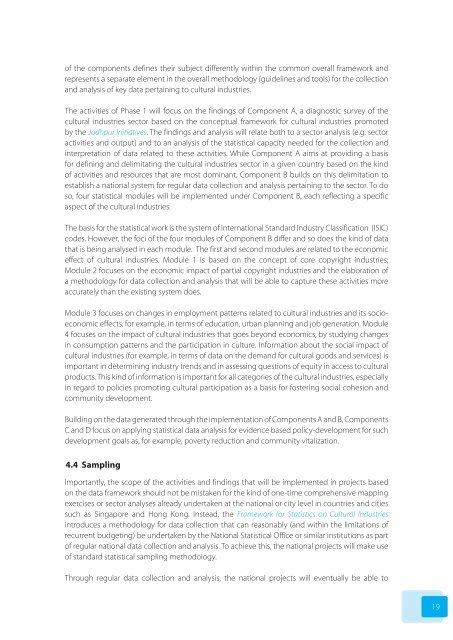Statistics on Cultural Industries - International Trade Centre
Statistics on Cultural Industries - International Trade Centre
Statistics on Cultural Industries - International Trade Centre
- No tags were found...
Create successful ePaper yourself
Turn your PDF publications into a flip-book with our unique Google optimized e-Paper software.
of the comp<strong>on</strong>ents defines their subject differently within the comm<strong>on</strong> overall framework andrepresents a separate element in the overall methodology (guidelines and tools) for the collecti<strong>on</strong>and analysis of key data pertaining to cultural industries.The activities of Phase 1 will focus <strong>on</strong> the findings of Comp<strong>on</strong>ent A, a diagnostic survey of thecultural industries sector based <strong>on</strong> the c<strong>on</strong>ceptual framework for cultural industries promotedby the Jodhpur Initiatives. The findings and analysis will relate both to a sector analysis (e.g. sectoractivities and output) and to an analysis of the statistical capacity needed for the collecti<strong>on</strong> andinterpretati<strong>on</strong> of data related to these activities. While Comp<strong>on</strong>ent A aims at providing a basisfor defining and delimitating the cultural industries sector in a given country based <strong>on</strong> the kindof activities and resources that are most dominant, Comp<strong>on</strong>ent B builds <strong>on</strong> this delimitati<strong>on</strong> toestablish a nati<strong>on</strong>al system for regular data collecti<strong>on</strong> and analysis pertaining to the sector. To doso, four statistical modules will be implemented under Comp<strong>on</strong>ent B, each reflecting a specificaspect of the cultural industries.The basis for the statistical work is the system of Internati<strong>on</strong>al Standard Industry Classificati<strong>on</strong> (ISIC)codes. However, the foci of the four modules of Comp<strong>on</strong>ent B differ and so does the kind of datathat is being analysed in each module. The first and sec<strong>on</strong>d modules are related to the ec<strong>on</strong>omiceffect of cultural industries. Module 1 is based <strong>on</strong> the c<strong>on</strong>cept of core copyright industries;Module 2 focuses <strong>on</strong> the ec<strong>on</strong>omic impact of partial copyright industries and the elaborati<strong>on</strong> ofa methodology for data collecti<strong>on</strong> and analysis that will be able to capture these activities moreaccurately than the existing system does.Module 3 focuses <strong>on</strong> changes in employment patterns related to cultural industries and its socioec<strong>on</strong>omiceffects, for example, in terms of educati<strong>on</strong>, urban planning and job generati<strong>on</strong>. Module4 focuses <strong>on</strong> the impact of cultural industries that goes bey<strong>on</strong>d ec<strong>on</strong>omics, by studying changesin c<strong>on</strong>sumpti<strong>on</strong> patterns and the participati<strong>on</strong> in culture. Informati<strong>on</strong> about the social impact ofcultural industries (for example, in terms of data <strong>on</strong> the demand for cultural goods and services) isimportant in determining industry trends and in assessing questi<strong>on</strong>s of equity in access to culturalproducts. This kind of informati<strong>on</strong> is important for all categories of the cultural industries, especiallyin regard to policies promoting cultural participati<strong>on</strong> as a basis for fostering social cohesi<strong>on</strong> andcommunity development.Building <strong>on</strong> the data generated through the implementati<strong>on</strong> of Comp<strong>on</strong>ents A and B, Comp<strong>on</strong>entsC and D focus <strong>on</strong> applying statistical data analysis for evidence based policy-development for suchdevelopment goals as, for example, poverty reducti<strong>on</strong> and community vitalizati<strong>on</strong>.4.4 SamplingImportantly, the scope of the activities and findings that will be implemented in projects based<strong>on</strong> the data framework should not be mistaken for the kind of <strong>on</strong>e-time comprehensive mappingexercises or sector analyses already undertaken at the nati<strong>on</strong>al or city level in countries and citiessuch as Singapore and H<strong>on</strong>g K<strong>on</strong>g. Instead, the Framework for <str<strong>on</strong>g>Statistics</str<strong>on</strong>g> <strong>on</strong> <strong>Cultural</strong> <strong>Industries</strong>introduces a methodology for data collecti<strong>on</strong> that can reas<strong>on</strong>ably (and within the limitati<strong>on</strong>s ofrecurrent budgeting) be undertaken by the Nati<strong>on</strong>al Statistical Office or similar instituti<strong>on</strong>s as partof regular nati<strong>on</strong>al data collecti<strong>on</strong> and analysis. To achieve this, the nati<strong>on</strong>al projects will make useof standard statistical sampling methodology.Through regular data collecti<strong>on</strong> and analysis, the nati<strong>on</strong>al projects will eventually be able to19
















